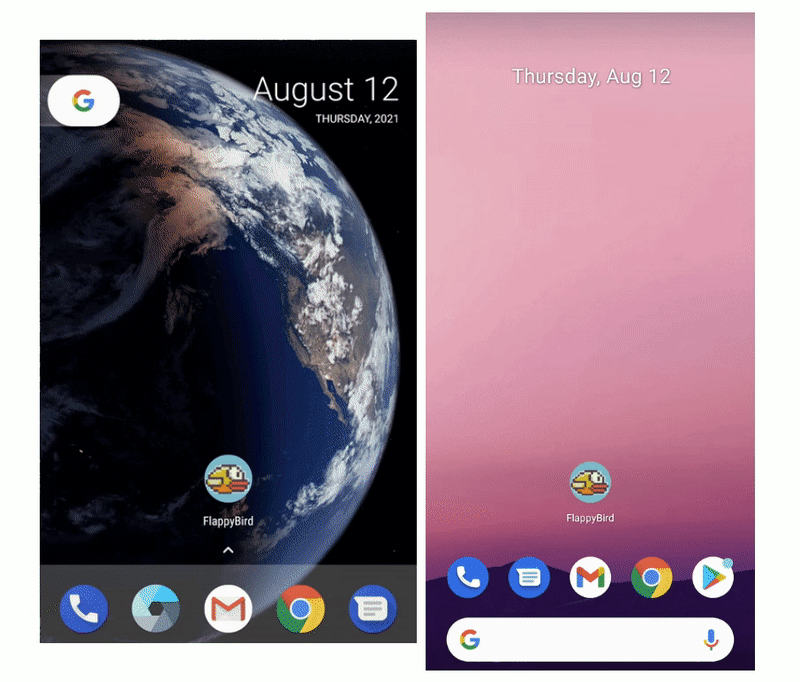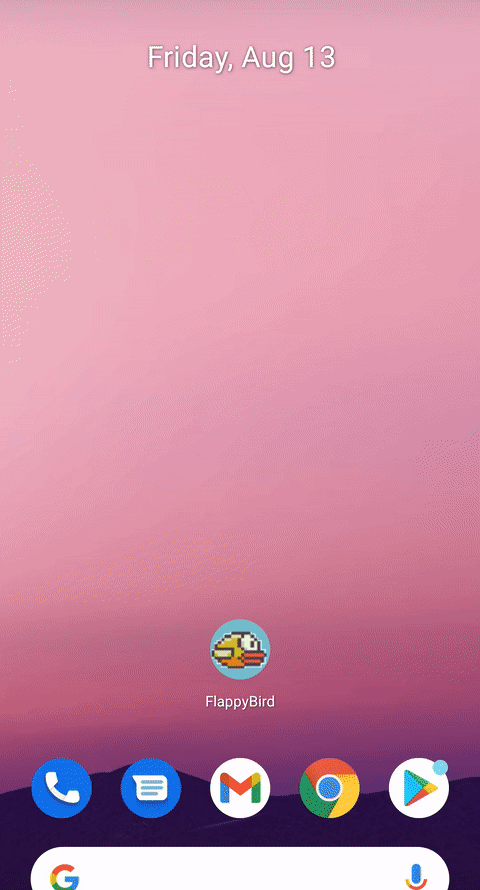Android 12上新引入的Splash Screen功能,可以高效打造自由、丰富的应用启动效果。但仍占据市场主流的低版本设备,如何才能尝上鲜呢?答案就是Jetpack的新成员SplashScreen库,让我们一探其用法以及背后的原理!
前言
早在Android 12 Preview版公开的时候,我注意到了酷炫的Splash Screen功能,便快速定制和分享了用它打造的各式启动效果,收到了很多积极的反馈。万分荣幸的是:负责Splash Screen功能的Google工程师也给我的Demo点了赞,还进行了转发!
但不少开发者表示Android 12上的效果固然不错,可12之前的版本才是主流,如果不兼容的话,实属有些鸡肋。包括我在内,都很关心低版本如何才能应用上这个新功能。
翻阅这位Google工程师的历史推文的时候,意外发现不久前AndroidX包也刚推出了一个叫SplashScreen的同名API。我们都知道AndroidX归属Jetpack,是独立于SDK版本以外的开发框架集合,很显然它就是用来兼容低版本的Splash Screen功能库。
这可谓是及时雨啊,必须研究一下,让Splash Screen功能充分发挥它的作用!加上之前分享的文章没有提及实现原理,本文一并探讨一下。
1. 新成员SplashScreen
Jetpack SplashScreen是向后兼容Android 12 Splash Screen功能的开发库。 其最早支持到Android 6(API 23),全球的Android设备中6及以上的版本占用率达到了9成以上,可以说完全够用了。
1.1 作用以及局限
Splash Screen功能打造的启动画面分为进场和退场两部分:前者负责展示Icon、Icon动画以及品牌Logo等基本信息,后者则用于展示整体或Icon视图过渡到目标画面的动画效果。
对于退场部分而言,无论是否运行在12上,Jetpack SplashScreen库都能达到Android 12同等效果;但进场部分如果是运行在低版本上,暂时存在些局限。
- 暂不支持展示Icon动画:
AnimatedVectorDrawable - 暂不支持配置Icon背景:
IconBackgroundColor - 暂不支持设置品牌Logo:
BrandingImage
| 进场部分的功能对比 | Jetpack版 | Android 12版 |
|---|---|---|
| ScreenBackground | YES | YES |
| ScreenIcon | YES | YES |
| AnimatedVectorDrawable | NA | YES |
| IconBackgroundColor | NA | YES |
| BrandingImage | NA | YES |
备注:后面会讲到SplashScreen库的实现原理,面向低版本的进场效果本质上是一个LayerDrawable。说实话,对于支持Vector Drawable动画、Adaptive Icon背景是无能为力的。但笔者认为在代码层面加入些额外处理,是可以做到完美支持的,期待后期升级能完善一下!
2.2 导入依赖
SplashScreen库的最新版本为1.0.0-alpha01,Gradle里简单依赖即可。
dependencies {
def core_version = "1.6.0"
...
// Optional - APIs for SplashScreen, including compatiblity helpers on devices prior Android 12
implementation "androidx.core:core-splashscreen:1.0.0-alpha01"
}
复制代码2.3 SplashScreen库预设主题
SplashScreen库针对启动画面的打造定义了专用的Attr,比如设置Icon和画面背景的windowSplashScreenAnimatedIcon和windowSplashScreenBackground,以及设置启动画面退出后Activity主题的postSplashScreenTheme等。
低版本并不支持Icon动画,也就谈不上配置时长,但库还是提供了相关的属性windowSplashScreenAnimationDuration,原因不太清楚。
<attr format="reference" name="postSplashScreenTheme"/>
<attr format="reference" name="windowSplashScreenAnimatedIcon"/>
<attr format="integer" name="windowSplashScreenAnimationDuration"/>
<attr format="color" name="windowSplashScreenBackground"/>
复制代码此外为了简化App端的配置,还预设了主题,同时并针对设备版本进行了区分。
如下是面向低版本的主题:
<style name="Theme.SplashScreen" parent="Theme.SplashScreenBase">
<item name="postSplashScreenTheme">?android:attr/theme</item>
<item name="windowSplashScreenAnimationDuration">@integer/default_icon_animation_duration</item>
<item name="windowSplashScreenBackground">@android:color/background_light</item>
<item name="windowSplashScreenAnimatedIcon">@android:drawable/sym_def_app_icon</item>
</style>
<style name="Theme.SplashScreenBase" parent="android:Theme.NoTitleBar">
<item name="android:windowBackground">@drawable/compat_splash_screen</item>
<item name="android:opacity">opaque</item>
<item name="android:windowDrawsSystemBarBackgrounds">true</item>
<item name="android:fitsSystemWindows">false</item>
<item name="android:statusBarColor">@android:color/transparent</item>
<item name="android:navigationBarColor">@android:color/transparent</item>
</style>
复制代码比较关键的是父主题SplashScreenBase设置了windowBackground属性,其指向的Drawable负责展示低版本的启动画面。
原理很简单:读取windowSplashScreenBackground设置的背景ColorDrawable和windowSplashScreenAnimatedIcon设置的图标Drawable,图标 Drawable放置到背景Drawable的中央,然后组合成Layer Drawable。老实说,跟我们以前自定义启动画面的思路是类似的。
<layer-list xmlns:android="http://schemas.android.com/apk/res/android">
<item android:gravity="fill">
<color android:color="?attr/windowSplashScreenBackground" />
</item>
<item
android:drawable="?attr/windowSplashScreenAnimatedIcon"
android:gravity="center"
android:width="@dimen/splashscreen_icon_size"
android:height="@dimen/splashscreen_icon_size" />
</layer-list>
复制代码因12版本提供了Splash Screen功能的系统属性,所以针对12及以上的主题,只需要将库定义的属性转化为系统属性。
<style name="Theme.SplashScreen" parent="android:Theme.DeviceDefault.NoActionBar">
<item name="android:windowSplashScreenAnimatedIcon">?windowSplashScreenAnimatedIcon</item>
<item name="android:windowSplashScreenBackground">?windowSplashScreenBackground</item>
<item name="android:windowSplashScreenAnimationDuration"> ?windowSplashScreenAnimationDuration</item>
</style>
复制代码2. 打造进场效果
在原有的Demo上适配新的API,感觉缺乏新意。之前用Jetpack Compose复刻的Flappy Bird游戏没来得及设计启动画面,那这次就利用Jetpack的SplashScreen库完善一下。
2.1 准备动画图标
Flappy Bird游戏的Logo是一个小鸟,目前只有一张PNG,要定制Icon动画效果的话要转为SVG。
找了很多工具,终于发现一个可以将PNG完美转换为SVG的网站:支持添加和删除各种颜色区域,进而可以最大程度地还原每个色块,每个Path。
通过AS自带的Vector Asset Tool和Animated Vector Drawable标签,可以将SVG扩展成格式效果的矢量图动画文件。
<animated-vector ...>
<aapt:attr name="android:drawable">
<vector
android:width="400dp"
android:height="404.73373dp"
...>
<group
android:name="BirdGroup"
android:pivotX="200"
android:pivotY="202"
android:rotation="0">
<path
android:fillColor="#503745"
android:fillType="evenOdd"
android:pathData="M173.7,133.065C173.419,133.178 ..."
android:strokeColor="#00000000" />
...
</group>
</vector>
</aapt:attr>
<target android:name="BirdGroup">
<aapt:attr name="android:animation">
<set>
<objectAnimator
android:duration="@integer/icon_animator_duration"
android:interpolator="@android:anim/decelerate_interpolator"
android:propertyName="translateX"
android:valueFrom="@integer/icon_animator_translate_from"
android:valueTo="@integer/icon_animator_translate_to" />
...
</set>
</aapt:attr>
</target>
</animated-vector>
复制代码2.2 适配主题
Android 12上给入口Activity指定Splash Screen功能的相关属性就可以实现进场效果。SplashScreen库也是一样的思路,不过为了简化代码,我们可以给Activity配置库预设好的主题。
因App端要给这些属性指定独有的资源,所以主题还需要简单扩展下,同时也要针对版本进行区分。如果碰巧最早也支持到Android 6的话,配置默认主题和面向12的values-v31主题即可,不然还需要配置面向6~11的values-23主题。
默认主题必须继扩展自预设主题Theme.SplashScreen,同时覆写一下Icon、Duration和ScreenBackground三个属性。因面向12的主题的部分属性和默认主题是一致的,所以将共通的部分抽出到Base中复用。
<style name="JetpackSplashTheme" parent="JetpackSplashTheme.Base">
</style>
<style name="JetpackSplashTheme.Base" parent="Theme.SplashScreen">
...
<item name="windowSplashScreenAnimatedIcon">@drawable/ic_icon_bird_small_animated_translate</item>
<item name="windowSplashScreenAnimationDuration">@integer/icon_animator_duration</item>
<item name="windowSplashScreenBackground">@color/appBackground</item>
<item name="postSplashScreenTheme">@style/SplashActivityTheme</item>
</style>
<style name="SplashActivityTheme" parent="Theme.MaterialComponents.DayNight.NoActionBar">
<item name="colorPrimary">@color/purple_500</item>
<item name="colorPrimaryDark">@color/purple_700</item>
<item name="colorAccent">@color/teal_200</item>
</style>
复制代码需要提醒的是,最好指定下postSplashScreenTheme属性。因为后续的定制效果需要用到SplashScreen类,而它将严格检查要求这个属性的配置,否则会发生Crash。
Cannot set AppTheme. No theme value defined for attribute postSplashScreenTheme.
另外,大部分Activity一般继承自AppCompat框架提供的Activity,该框架要求画面必须配置AppCompat系主题。也就是说,postSplashScreenTheme属性不仅要指定,还得是AppCompat系主题!
备注:AppCompat框架作此限制的原因,可以在之前写的文章里查看「深度解读Jetpack框架的基石-AppCompat」。
You need to use a Theme.AppCompat theme!
通过复用共通主题,面向12的主题只需要指定Icon背景属性IconBackgroundColor和品牌Logo属性BrandingImage。
<style name="JetpackSplashTheme" parent="JetpackSplashTheme.Base">
<item name="android:windowSplashScreenIconBackgroundColor">@color/skyBlue</item>
<item name="android:windowSplashScreenBrandingImage">@drawable/ic_tm_brand_newer</item>
</style>
复制代码下面是分别运行在Android 8.1和12上的启动画面进场效果,小鸟从左边入场并逐渐放大的动画。
再比如小鸟旋转着放大进场动画。
事实上Animated Vector Drawable所支持的Path动画更加炫酷和灵活,可以打造更丰富的动画体验,大家可以试试!
2.3 优化低版本的进场Icon
通过对比,可以看到8.1的进场效果里确实没有展示Icon动画,也没有Icon背景和品牌Logo。为了尽可能和12的进场效果接近,可以将低版本主题的图标属性改为Adaptive Icon,面向12的主题才使用动画Icon。
<!-- 默认主题:面向12之前的版本 -->
<style name="JetpackSplashTheme" parent="JetpackSplashTheme.Base">
<!-- Adaptive icon drawable -->
<item name="windowSplashScreenAnimatedIcon">@mipmap/ic_launcher_bird_final</item>
</style>
<!-- 面向12的版本 -->
<style name="JetpackSplashTheme" parent="JetpackSplashTheme.Base">
<!-- Animated vector drawable -->
<item name="windowSplashScreenAnimatedIcon">@drawable/ic_icon_bird_small_animated_translate</item>
...
</style>
复制代码3. 延长启动画面
3.1 获取SplashScreen定制入口
上述主题配置完就可以实现进场效果了,但为了进一步控制启动画面或定制退场效果,还得取得控制的入口即SplashScreen类。SplashScreen库提供的是installSplashScreen()。
class MainActivity : ComponentActivity() {
private val viewModel: GameViewModel by viewModels()
override fun onCreate(savedInstanceState: Bundle?) {
...
// Need to be called before setContentView or other view operation on the root view.
val splashScreen = installSplashScreen()
setContent { ... }
SplashScreenController(splashScreen, viewModel).apply {
customizeSplashScreen()
}
}
}
复制代码有一点需要留意一下:installSplashScreen()必须先于setContentView()调用,原因在于install函数会获取postSplashScreenTheme属性指定的主题,并在检查通过后setTheme给Activity。
需要明确一下:install函数只是执行一下主题和资源方面的初始化,此刻尚未加载退场使用的视图。
3.2 控制启动画面展示时长
当App的第一帧开始描画,启动画面Window即Splash Screen Window将退出。若描画已经开始,但部分关键逻辑还没执行完,这将影响完整的展示。这时候我们可以适当地延长启动画面,让用户再等一会儿。
Android 12并没有提供控制启动时长的API,之前的Demo是通过向ContentView注册OnPreDrawListener回调挂起描画来实现的。(挂起描画间接导致Splash Screen Window的延迟退出,进而达到延长启动画面的目的。)
SplashScreen库提供了专用API来处理这种需求,即KeepOnScreenCondition。我们需要告知SplashScreen需要持续展示的条件,在条件被破坏之前WMS将维持它的展示。事实上这个API的实现原理跟之前的思路是一致的。
class SplashScreenController( ... ) {
fun customizeSplashScreen() {
keepSplashScreenLonger()
...
}
// Keep splash screen showing till data initialized.
private fun keepSplashScreenLonger() {
splashScreen.setKeepVisibleCondition { !viewModel.isDataReady() }
}
}
复制代码可以看到启动画面的展示时间明显变长了。

4. 定制退场效果
为了使得启动画面能完美过渡到目标画面,退场效果的定制格外重要。而且相较于进场只能定制Icon动画,退场则能定制整体和Icon的各式动画,空间更大,也更灵活。
4.1 执行退场动画
Splash Screen Window在退出的时候,是执行退场动画的时机。通过SplashScreen库提供的OnExitAnimationListener API可以拿到这个时机,它同时会返回启动画面视图,便于后续的定制。
不同于Android 12,SplashScreen库启动画面视图统一封装到了SplashScreenViewProvider中。这个API将依据版本返回对应视图:低版本是自定义的FrameLayout,12则是版本专属的SplashScreenView。
fun customizeSplashScreen() {
...
customizeSplashScreenExit()
}
// Customize splash screen exit animator.
private fun customizeSplashScreenExit() {
splashScreen.setOnExitAnimationListener { splashScreenViewProvider ->
val onExit = {
splashScreenViewProvider.remove()
}
showSplashExitAnimator(splashScreenViewProvider.view, onExit)
showSplashIconExitAnimator(splashScreenViewProvider.iconView, onExit)
}
}
复制代码无论运行在哪个版本,通过统一提供的SplashScreenViewProvider实例,可以执行一致的动画效果。
比如针对整体视图做缩放和淡出动画。
private fun showSplashExitAnimator(splashScreenView: View, onExit: () -> Unit = {}) {
val alphaOut = ObjectAnimator.ofFloat(
splashScreenView,
...
)
val scaleOut = ObjectAnimator.ofFloat( ... )
AnimatorSet().run {
duration = defaultExitDuration
interpolator = AnticipateInterpolator()
playTogether(scaleOut, alphaOut)
start()
}
}
复制代码针对Icon视图做缩放、淡出和位移的动画。目的是让小鸟渐渐缩小并上移至游戏画面中,即无缝过渡到游戏区域。
private fun showSplashIconExitAnimator(iconView: View, onExit: () -> Unit = {}) {
val alphaOut = ObjectAnimator.ofFloat(
iconView,
...
)
val scaleOut = ObjectAnimator.ofFloat( ... )
val slideUp = ObjectAnimator.ofFloat( ... )
AnimatorSet().run {
...
playTogether(alphaOut, scaleOut, slideUp)
doOnEnd {
onExit()
}
start()
}
}
复制代码注意:退场动画结束后一定要调用remove()手动移除视图,否则可能会看到启动画面一直盖在App上,无法消失。对于12来说,这实际上是系统返回的SplashScreenView Surface一直残留在画面上,而低版本则是FrameLayout仍残存在ContentView树里。
4.2 优化退场动画时长
App开始描画的时候,无论进场动画是否执行完,Splash Screen Window都将退出,同时执行预设的退场动画。 而设备性能的优劣或负荷状态的不同,又会影响App描画的开始时机,所以退场动画的执行时机并不固定,随着设备的状况略微变化。
-
如果App描画得早,进场动画可能还没执行完。为了让用户更快看到目标内容,退场动画可以缩短执行时长,比如直接沿用进场动画的剩余时长
-
相反,如果描画得晚,进场动画早结束了。如果退场动画还再占用时间,那将严重耽误用户看到目标内容,造成启动卡顿的坏印象。所以这时候,退场动画可以执行很短的固定时长,甚至可以不执行
换句话说,退场动画本意是后台加载的缓冲和过渡,不能为了单纯展示动画牺牲启动体验,可以灵活控制退场的占用时长。
为了便于计算进场Icon动画的剩余时长,SplashScreen库提供了获取其开始时刻和总时长的API:
/**
* Start time of the icon animation.
*
* On API 31+, returns the number of millisecond since the Epoch time (1970-1-1T00:00:00Z)
*
* Below API 31, returns 0 because the icon cannot be animated.
*/
public val iconAnimationStartMillis: Long get() = impl.iconAnimationStartMillis
/**
* Duration of the icon animation as provided in attr.
*/
public val iconAnimationDurationMillis: Long get() = impl.iconAnimationDurationMillis
复制代码下面的代码演示了在退场动画执行前判断下进场动画是否完毕,完毕的话沿用动画剩余的时间,否则放弃执行。
private fun getRemainingDuration(splashScreenView: SplashScreenViewProvider): Long {
// Get the duration of the animated vector drawable.
val animationDuration = splashScreenView.iconAnimationDurationMillis
// Get the start time of the animation.
val animationStart = splashScreenView.iconAnimationStartMillis
// Calculate the remaining duration of the animation.
return if (animationDuration == 0L || animationStart == 0L)
defaultExitDuration
else (animationDuration - SystemClock.uptimeMillis() + animationStart)
.coerceAtLeast(0L)
}
复制代码前面说过低版本在进场的时候不支持Icon动画,那自然没有必要计算剩余时长。所以运行在低版本上的话,这两个API总是返回默认值0,值得留意!
private open class ViewImpl(val activity: Activity) {
open val iconAnimationStartMillis: Long get() = 0
open val iconAnimationDurationMillis: Long get() = 0
...
}
复制代码5. SplashScreen实现原理
Android 12的源码尚未公开,下面针对Jetpack SplashScreen库的源码进行解读。※之前觉得SplashScreen库提供的API简单明了,原理应该也不复杂。但深究源码后发现,不少细节和猜测存在出入,还是值得反复思考的。
5.1 总体架构
Activity通过SplashScreen库提供的SplashScreen实例可以获取到控制启动画面的入口,其内部将依据OS版本决定采用12的专属API还是自定义视图,来展示、延时或移除启动画面。
5.2 installSplashScreen
获取SplashScreen实例的installSplashScreen()将读取并设置目标Activity的Theme。如果运行在低版本上的话,还需要获取Icon和Background的配置。此刻只是获取,并未将退场用的自定义视图添加上来。
5.3 setKeepVisibleCondition
通过setKeepVisibleCondition()可以延长启动画面的展示,无关运行的版本,原理都是向ContentView的ViewTreeObserver注册OnPreDrawListener回调来实现。描画放行的时候,低版本额外需要手动执行退出的回调,12则由系统自行执行。
这个时候退场用的自定义视图仍然还没添加上来,只是延迟了Splash Screen Window的退出而已。
5.4 setOnExitAnimationListener
setOnExitAnimationListener()可以监听退场时机,SplashScreen会将启动画面视图准备好封装到SplashScreenViewProvider中,然后在启动画面需要退出的时候,通过OnExitAnimationListener接口回调。
低版本上视图相关的处理比较多,需要inflate一个自定义布局并添加到ContentView中,然后将install准备好的background和icon反映进来。
面向低版本添加的自定义布局 :
<FrameLayout ...>
<ImageView
android:id="@+id/splashscreen_icon_view"
android:layout_width="@dimen/splashscreen_icon_size"
android:layout_height="@dimen/splashscreen_icon_size"
android:layout_gravity="center" />
</FrameLayout>
复制代码5.5 adjustInsets特殊处理
SplashScreenViewProvider初始化后会额外调用adjustInsets(),而且只有面向低版本才实现了具体逻辑。一起来研究下这个特殊处理的用意。
先来看下函数的注释:
Adjust the insets to avoid any jump between the actual splash screen and the SplashScreen View.
字面意思是为了避免启动画面和SplashView视图之间发生跳跃,需要调整下视图的参数。好像还不是很理解,再结合下函数的具体实现:
private class Impl23(activity: Activity) : Impl(activity) {
override fun adjustInsets(
view: View,
splashScreenViewProvider: SplashScreenViewProvider
) {
// Offset the icon if the insets have changed
val rootWindowInsets = view.rootWindowInsets
val ty =
rootWindowInsets.systemWindowInsetTop - rootWindowInsets.systemWindowInsetBottom
splashScreenViewProvider.iconView.translationY = -ty.toFloat() / 2f
}
}
复制代码默认的adjustInsets()没有具体实现,只有低版本才有具体实现,这又是为什么?
处理的内容很直白:监听SplashScreenViewProvider里存放的View的布局变化,从中获取rootWindowInsets,将覆盖在Window的状态栏和导航栏的高度差值取中值,然后将Icon视图向上或向下进行移动。
- 前面的原理提到过低版本的进场效果实际上是将一个Layer Drawable设置到了
Window Background上,Icon在该Drawable里的位置是居中的,所以Icon在Splash Screen Window里也完全居中 - 但退场效果的画面视图并非Window Background Drawable,而是向ContentView中手动添加的
Framelayout布局。对于布局来说,Icon视图是居中的,但对于它所属的Window来说,因顶部的Statusbar和底部的NavigationBar的高度不同,最终Icon视图在Window整体的位置并不完全居中。尤其当设备采用Gesture Navigation导航模式的话,Icon视图偏下的情况更明显 - 12的退场视图可以说是Splash Screen Window的完整拷贝,不是自定义的ContentView子布局,不存在这个问题
总结来说,如果不加干预的话,低版本上从进场的Window Background到退场的FrameLayout时,App的Icon会发生错位或跳跃的违和感!
5.6 remove
setOnExitAnimationListener调用后,SplashScreen库会将启动画面的视图回调回来,执行完退场动画后需要调用remove()手动移除视图,它的原理很简单:
- 12之前就是将FrameLayout从ContentView树上移除
- 12则是调用专用的API即SplashScreenView#remove()
6. API总结
对SplashScreen库几个关键API做个整理:
| API | 说明 |
|---|---|
| SplashScreen | Jetpack版获取定制启动画面入口的类 |
| Activity#installSplashScreen() | 覆写Activity,用以获取定制入口的静态成员函数 |
| setKeepVisibleCondition | 指定保持启动画面展示的条件 |
| KeepOnScreenCondition | 实现展示条件的接口 |
| setOnExitAnimationListener | 监听启动画面的退出时机 |
| OnExitAnimationListener | 启动画面退出的回调接口 |
| SplashScreenViewProvider | 定制退场效果的启动画面视图 |
并和Android 12提供的版本做个简单对比:
| Attr对比 | Jetpack版 | Android 12版 |
|---|---|---|
| 指定目标Activity主题 | postSplashScreenTheme | - |
| 指定动画Icon | windowSplashScreenAnimatedIcon | android:windowSplashScreenAnimatedIcon |
| 指定启动画面背景 | windowSplashScreenBackground | android:windowSplashScreenBackground |
| 指定Icon动画时长 | windowSplashScreenAnimationDuration | android:windowSplashScreenAnimationDuration |
| 指定Icon背景 | - | android:windowSplashScreenIconBackgroundColor |
| 指定品牌Logo | - | android:windowSplashScreenBrandingImage |
| API对比 | Jetpack版 | Android 12版 |
|---|---|---|
| 启动画面定制入口 | class androidx.core.splashscreen.SplashScreen | interface android.window.SplashScreen |
| 入口实例获取 | Activity#installSplashScreen() | Activity#getSplashScreen() |
| 启动画面视图 | SplashScreenViewProvider | SplashScreenView |
7. 本文Demo
适配Splash Screen功能后的Compose版Flappy Bird游戏的整体效果:

8. 未决事项
通过上面的阐述已经知道:低版本上展示退场效果的启动画面,实质上是临时添加到App内部的FrameLayout。而12上显然不是这种方式,通过Dump命令发现退场的时候也没有创建额外的Window。
- 那么12上启动画面Window退出后提供给App定制退场效果的SplashScreenView到底是什么?
- 假使这个“View”并不属于App本身,那么App能够访问它并对属性做出改动,是如何实现的?
在决定搁置这个疑惑的时候,偶然发现下12上启动画面执行过程中会打印Splash相关关键字的系统日志:
StartingSurfaceDrawer: addSplashScreen com.ellison.flappybird: nonLocalizedLabel=null theme=7f1000e7 task= 334 StartingSurfaceDrawer: window attributes color: ffecfcdd icon android.graphics.drawable.AnimatedVectorDrawable... StartingSurfaceDrawer: fillViewWithIcon surfaceWindowView android.window.SplashScreenView... StartingSurfaceDrawer: Copying splash screen window view for task: 334 parcelable? android.window.SplashScreenView$SplashScreenViewParcelable StartingSurfaceDrawer: Task start finish, remove starting surface for task 334 StartingSurfaceDrawer: Removing splash screen window for task: 334
于是我大胆猜测,StartingSurfaceDrawer负责通过WMS读取、展示和移除App设置的Splash Screen Window视图。并在Window退出前通过WMS通知目标Activity的PhoneWindow,从Splash Screen Window里复原视图,然后将复原得到的SplashScreenView添加到App画面上。因为PhoneWindow直接持有DecorView,所以可能直接附着到DecorView上去。
StartingSurfaceDrawer到底是谁、猜测是否正确以及具体的细节,还有待12的源码公开后再做深入地研究~
结语
起初推测因为Android 6以上的版本已是市场主流,才决定让SplashScreen库最早兼容到这个版本。后面探究原理的时候,发现其内部调用的adjustInsets()处理依赖一个版本6才加入的API,所以又感觉这才是兼容到6的真正原因。
兼容到Android 6版本是出于占用率的考虑还是源于API的限制已不再重要,关键是Splash Screen功能已支持足够多的Android设备。
之前你们说Android 12全新的Splash Screen功能虽然很酷,但不兼容低版本,略显鸡肋。如今有了Jetpack SplashScreen库的加持,总该适配起来了吧?
参考资料
A peek inside Jetpack Core Splashscreen
Meet the Jetpack Splashscreen API: a definitive guide for splash screens in Android